Legal Analysis: Business Structures (Partnerships, Trusts, Companies)
VerifiedAdded on 2021/12/08
|10
|3423
|70
Report
AI Summary
This report provides a comprehensive analysis of different business structures, including partnerships, trusts, and companies, evaluating their legal characteristics, rights, duties, and liabilities. It examines the key provisions of the Partnership Act 1891 (Qld), the Trusts Act 1973 (Qld), and the Corporations Act 2001 (Cth) to determine the advantages and disadvantages of each structure. The report delves into the elements required for forming partnerships, the nature of trusts, and the legal complexities of companies, referencing key cases like Checker Taxicab v Stone and Salomon v Salomon & Co Ltd. Furthermore, the report outlines the rights and obligations of partners, trustees, shareholders, and directors, along with their respective liabilities. The analysis aims to assist individuals in selecting the most suitable business structure based on their specific requirements and objectives, ultimately providing a recommendation for Oliver and Emma to guide their decision-making process. The report is available on Desklib, a platform that provides all the necessary AI based study tools for students.

0 | P a g e
Corporations and Business Structure
Corporations and Business Structure
Paraphrase This Document
Need a fresh take? Get an instant paraphrase of this document with our AI Paraphraser
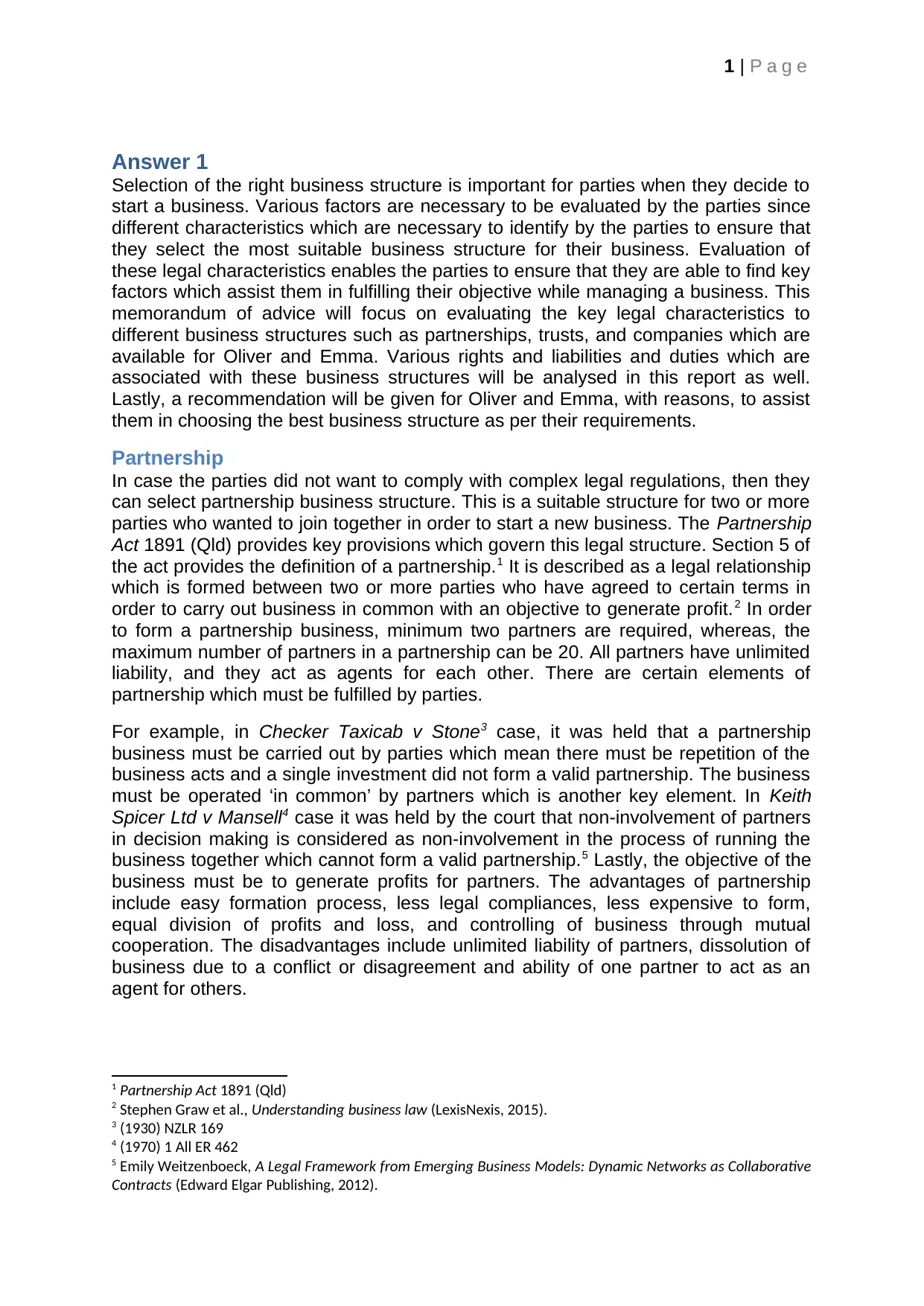
1 | P a g e
Answer 1
Selection of the right business structure is important for parties when they decide to
start a business. Various factors are necessary to be evaluated by the parties since
different characteristics which are necessary to identify by the parties to ensure that
they select the most suitable business structure for their business. Evaluation of
these legal characteristics enables the parties to ensure that they are able to find key
factors which assist them in fulfilling their objective while managing a business. This
memorandum of advice will focus on evaluating the key legal characteristics to
different business structures such as partnerships, trusts, and companies which are
available for Oliver and Emma. Various rights and liabilities and duties which are
associated with these business structures will be analysed in this report as well.
Lastly, a recommendation will be given for Oliver and Emma, with reasons, to assist
them in choosing the best business structure as per their requirements.
Partnership
In case the parties did not want to comply with complex legal regulations, then they
can select partnership business structure. This is a suitable structure for two or more
parties who wanted to join together in order to start a new business. The Partnership
Act 1891 (Qld) provides key provisions which govern this legal structure. Section 5 of
the act provides the definition of a partnership.1 It is described as a legal relationship
which is formed between two or more parties who have agreed to certain terms in
order to carry out business in common with an objective to generate profit.2 In order
to form a partnership business, minimum two partners are required, whereas, the
maximum number of partners in a partnership can be 20. All partners have unlimited
liability, and they act as agents for each other. There are certain elements of
partnership which must be fulfilled by parties.
For example, in Checker Taxicab v Stone3 case, it was held that a partnership
business must be carried out by parties which mean there must be repetition of the
business acts and a single investment did not form a valid partnership. The business
must be operated ‘in common’ by partners which is another key element. In Keith
Spicer Ltd v Mansell4 case it was held by the court that non-involvement of partners
in decision making is considered as non-involvement in the process of running the
business together which cannot form a valid partnership.5 Lastly, the objective of the
business must be to generate profits for partners. The advantages of partnership
include easy formation process, less legal compliances, less expensive to form,
equal division of profits and loss, and controlling of business through mutual
cooperation. The disadvantages include unlimited liability of partners, dissolution of
business due to a conflict or disagreement and ability of one partner to act as an
agent for others.
1 Partnership Act 1891 (Qld)
2 Stephen Graw et al., Understanding business law (LexisNexis, 2015).
3 (1930) NZLR 169
4 (1970) 1 All ER 462
5 Emily Weitzenboeck, A Legal Framework from Emerging Business Models: Dynamic Networks as Collaborative
Contracts (Edward Elgar Publishing, 2012).
Answer 1
Selection of the right business structure is important for parties when they decide to
start a business. Various factors are necessary to be evaluated by the parties since
different characteristics which are necessary to identify by the parties to ensure that
they select the most suitable business structure for their business. Evaluation of
these legal characteristics enables the parties to ensure that they are able to find key
factors which assist them in fulfilling their objective while managing a business. This
memorandum of advice will focus on evaluating the key legal characteristics to
different business structures such as partnerships, trusts, and companies which are
available for Oliver and Emma. Various rights and liabilities and duties which are
associated with these business structures will be analysed in this report as well.
Lastly, a recommendation will be given for Oliver and Emma, with reasons, to assist
them in choosing the best business structure as per their requirements.
Partnership
In case the parties did not want to comply with complex legal regulations, then they
can select partnership business structure. This is a suitable structure for two or more
parties who wanted to join together in order to start a new business. The Partnership
Act 1891 (Qld) provides key provisions which govern this legal structure. Section 5 of
the act provides the definition of a partnership.1 It is described as a legal relationship
which is formed between two or more parties who have agreed to certain terms in
order to carry out business in common with an objective to generate profit.2 In order
to form a partnership business, minimum two partners are required, whereas, the
maximum number of partners in a partnership can be 20. All partners have unlimited
liability, and they act as agents for each other. There are certain elements of
partnership which must be fulfilled by parties.
For example, in Checker Taxicab v Stone3 case, it was held that a partnership
business must be carried out by parties which mean there must be repetition of the
business acts and a single investment did not form a valid partnership. The business
must be operated ‘in common’ by partners which is another key element. In Keith
Spicer Ltd v Mansell4 case it was held by the court that non-involvement of partners
in decision making is considered as non-involvement in the process of running the
business together which cannot form a valid partnership.5 Lastly, the objective of the
business must be to generate profits for partners. The advantages of partnership
include easy formation process, less legal compliances, less expensive to form,
equal division of profits and loss, and controlling of business through mutual
cooperation. The disadvantages include unlimited liability of partners, dissolution of
business due to a conflict or disagreement and ability of one partner to act as an
agent for others.
1 Partnership Act 1891 (Qld)
2 Stephen Graw et al., Understanding business law (LexisNexis, 2015).
3 (1930) NZLR 169
4 (1970) 1 All ER 462
5 Emily Weitzenboeck, A Legal Framework from Emerging Business Models: Dynamic Networks as Collaborative
Contracts (Edward Elgar Publishing, 2012).
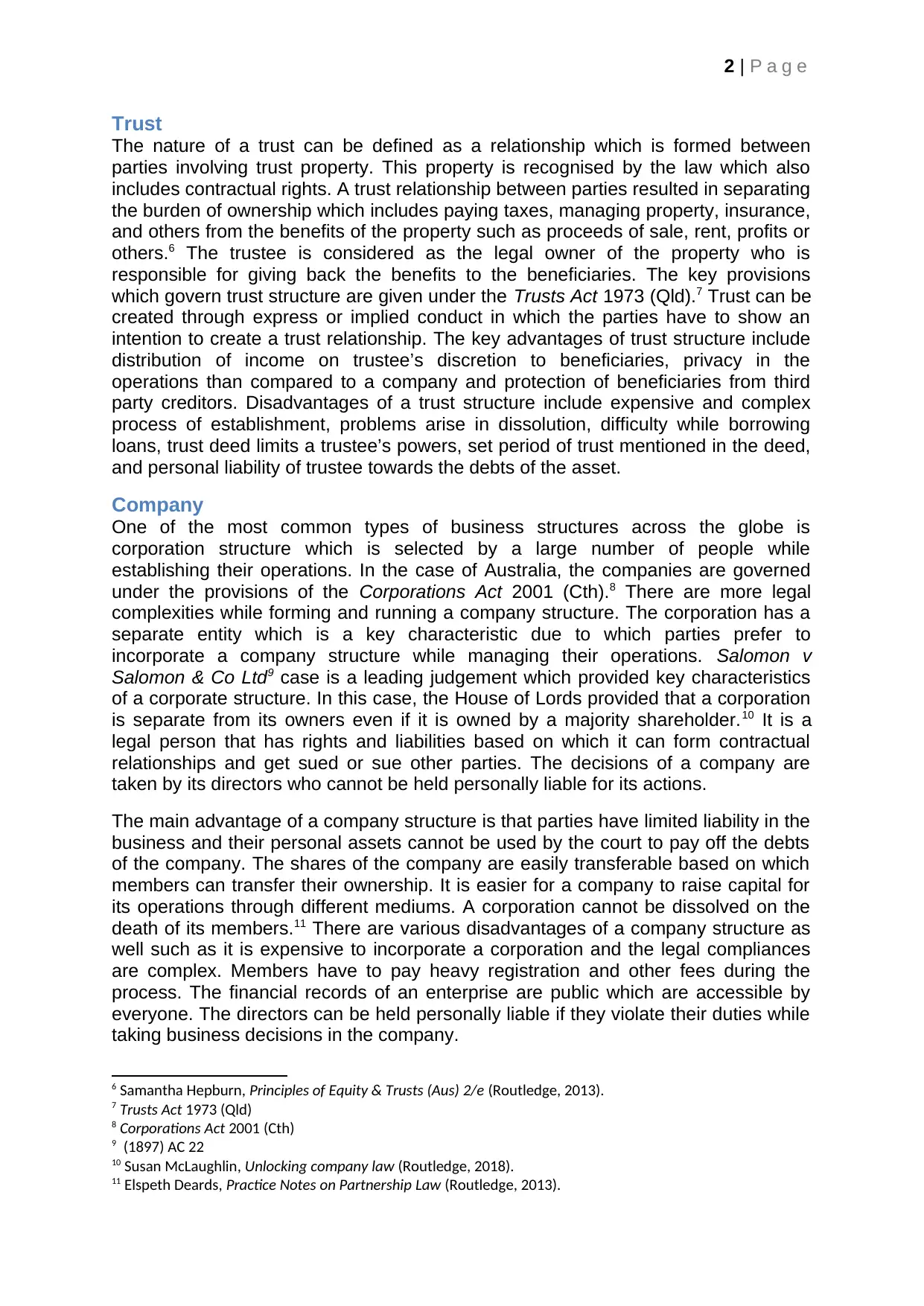
2 | P a g e
Trust
The nature of a trust can be defined as a relationship which is formed between
parties involving trust property. This property is recognised by the law which also
includes contractual rights. A trust relationship between parties resulted in separating
the burden of ownership which includes paying taxes, managing property, insurance,
and others from the benefits of the property such as proceeds of sale, rent, profits or
others.6 The trustee is considered as the legal owner of the property who is
responsible for giving back the benefits to the beneficiaries. The key provisions
which govern trust structure are given under the Trusts Act 1973 (Qld).7 Trust can be
created through express or implied conduct in which the parties have to show an
intention to create a trust relationship. The key advantages of trust structure include
distribution of income on trustee’s discretion to beneficiaries, privacy in the
operations than compared to a company and protection of beneficiaries from third
party creditors. Disadvantages of a trust structure include expensive and complex
process of establishment, problems arise in dissolution, difficulty while borrowing
loans, trust deed limits a trustee’s powers, set period of trust mentioned in the deed,
and personal liability of trustee towards the debts of the asset.
Company
One of the most common types of business structures across the globe is
corporation structure which is selected by a large number of people while
establishing their operations. In the case of Australia, the companies are governed
under the provisions of the Corporations Act 2001 (Cth).8 There are more legal
complexities while forming and running a company structure. The corporation has a
separate entity which is a key characteristic due to which parties prefer to
incorporate a company structure while managing their operations. Salomon v
Salomon & Co Ltd9 case is a leading judgement which provided key characteristics
of a corporate structure. In this case, the House of Lords provided that a corporation
is separate from its owners even if it is owned by a majority shareholder.10 It is a
legal person that has rights and liabilities based on which it can form contractual
relationships and get sued or sue other parties. The decisions of a company are
taken by its directors who cannot be held personally liable for its actions.
The main advantage of a company structure is that parties have limited liability in the
business and their personal assets cannot be used by the court to pay off the debts
of the company. The shares of the company are easily transferable based on which
members can transfer their ownership. It is easier for a company to raise capital for
its operations through different mediums. A corporation cannot be dissolved on the
death of its members.11 There are various disadvantages of a company structure as
well such as it is expensive to incorporate a corporation and the legal compliances
are complex. Members have to pay heavy registration and other fees during the
process. The financial records of an enterprise are public which are accessible by
everyone. The directors can be held personally liable if they violate their duties while
taking business decisions in the company.
6 Samantha Hepburn, Principles of Equity & Trusts (Aus) 2/e (Routledge, 2013).
7 Trusts Act 1973 (Qld)
8 Corporations Act 2001 (Cth)
9 (1897) AC 22
10 Susan McLaughlin, Unlocking company law (Routledge, 2018).
11 Elspeth Deards, Practice Notes on Partnership Law (Routledge, 2013).
Trust
The nature of a trust can be defined as a relationship which is formed between
parties involving trust property. This property is recognised by the law which also
includes contractual rights. A trust relationship between parties resulted in separating
the burden of ownership which includes paying taxes, managing property, insurance,
and others from the benefits of the property such as proceeds of sale, rent, profits or
others.6 The trustee is considered as the legal owner of the property who is
responsible for giving back the benefits to the beneficiaries. The key provisions
which govern trust structure are given under the Trusts Act 1973 (Qld).7 Trust can be
created through express or implied conduct in which the parties have to show an
intention to create a trust relationship. The key advantages of trust structure include
distribution of income on trustee’s discretion to beneficiaries, privacy in the
operations than compared to a company and protection of beneficiaries from third
party creditors. Disadvantages of a trust structure include expensive and complex
process of establishment, problems arise in dissolution, difficulty while borrowing
loans, trust deed limits a trustee’s powers, set period of trust mentioned in the deed,
and personal liability of trustee towards the debts of the asset.
Company
One of the most common types of business structures across the globe is
corporation structure which is selected by a large number of people while
establishing their operations. In the case of Australia, the companies are governed
under the provisions of the Corporations Act 2001 (Cth).8 There are more legal
complexities while forming and running a company structure. The corporation has a
separate entity which is a key characteristic due to which parties prefer to
incorporate a company structure while managing their operations. Salomon v
Salomon & Co Ltd9 case is a leading judgement which provided key characteristics
of a corporate structure. In this case, the House of Lords provided that a corporation
is separate from its owners even if it is owned by a majority shareholder.10 It is a
legal person that has rights and liabilities based on which it can form contractual
relationships and get sued or sue other parties. The decisions of a company are
taken by its directors who cannot be held personally liable for its actions.
The main advantage of a company structure is that parties have limited liability in the
business and their personal assets cannot be used by the court to pay off the debts
of the company. The shares of the company are easily transferable based on which
members can transfer their ownership. It is easier for a company to raise capital for
its operations through different mediums. A corporation cannot be dissolved on the
death of its members.11 There are various disadvantages of a company structure as
well such as it is expensive to incorporate a corporation and the legal compliances
are complex. Members have to pay heavy registration and other fees during the
process. The financial records of an enterprise are public which are accessible by
everyone. The directors can be held personally liable if they violate their duties while
taking business decisions in the company.
6 Samantha Hepburn, Principles of Equity & Trusts (Aus) 2/e (Routledge, 2013).
7 Trusts Act 1973 (Qld)
8 Corporations Act 2001 (Cth)
9 (1897) AC 22
10 Susan McLaughlin, Unlocking company law (Routledge, 2018).
11 Elspeth Deards, Practice Notes on Partnership Law (Routledge, 2013).
⊘ This is a preview!⊘
Do you want full access?
Subscribe today to unlock all pages.

Trusted by 1+ million students worldwide

3 | P a g e
Paraphrase This Document
Need a fresh take? Get an instant paraphrase of this document with our AI Paraphraser
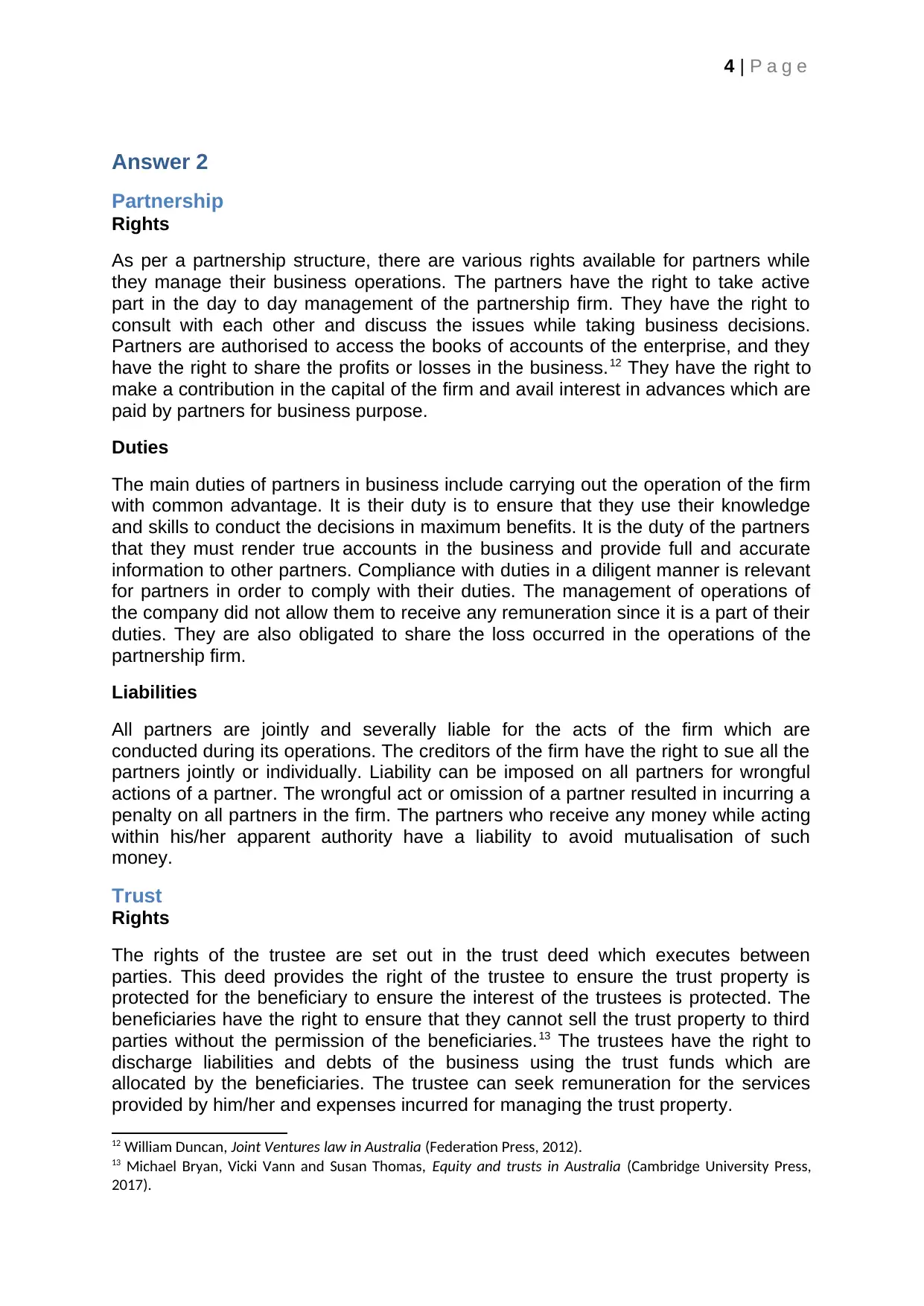
4 | P a g e
Answer 2
Partnership
Rights
As per a partnership structure, there are various rights available for partners while
they manage their business operations. The partners have the right to take active
part in the day to day management of the partnership firm. They have the right to
consult with each other and discuss the issues while taking business decisions.
Partners are authorised to access the books of accounts of the enterprise, and they
have the right to share the profits or losses in the business.12 They have the right to
make a contribution in the capital of the firm and avail interest in advances which are
paid by partners for business purpose.
Duties
The main duties of partners in business include carrying out the operation of the firm
with common advantage. It is their duty is to ensure that they use their knowledge
and skills to conduct the decisions in maximum benefits. It is the duty of the partners
that they must render true accounts in the business and provide full and accurate
information to other partners. Compliance with duties in a diligent manner is relevant
for partners in order to comply with their duties. The management of operations of
the company did not allow them to receive any remuneration since it is a part of their
duties. They are also obligated to share the loss occurred in the operations of the
partnership firm.
Liabilities
All partners are jointly and severally liable for the acts of the firm which are
conducted during its operations. The creditors of the firm have the right to sue all the
partners jointly or individually. Liability can be imposed on all partners for wrongful
actions of a partner. The wrongful act or omission of a partner resulted in incurring a
penalty on all partners in the firm. The partners who receive any money while acting
within his/her apparent authority have a liability to avoid mutualisation of such
money.
Trust
Rights
The rights of the trustee are set out in the trust deed which executes between
parties. This deed provides the right of the trustee to ensure the trust property is
protected for the beneficiary to ensure the interest of the trustees is protected. The
beneficiaries have the right to ensure that they cannot sell the trust property to third
parties without the permission of the beneficiaries.13 The trustees have the right to
discharge liabilities and debts of the business using the trust funds which are
allocated by the beneficiaries. The trustee can seek remuneration for the services
provided by him/her and expenses incurred for managing the trust property.
12 William Duncan, Joint Ventures law in Australia (Federation Press, 2012).
13 Michael Bryan, Vicki Vann and Susan Thomas, Equity and trusts in Australia (Cambridge University Press,
2017).
Answer 2
Partnership
Rights
As per a partnership structure, there are various rights available for partners while
they manage their business operations. The partners have the right to take active
part in the day to day management of the partnership firm. They have the right to
consult with each other and discuss the issues while taking business decisions.
Partners are authorised to access the books of accounts of the enterprise, and they
have the right to share the profits or losses in the business.12 They have the right to
make a contribution in the capital of the firm and avail interest in advances which are
paid by partners for business purpose.
Duties
The main duties of partners in business include carrying out the operation of the firm
with common advantage. It is their duty is to ensure that they use their knowledge
and skills to conduct the decisions in maximum benefits. It is the duty of the partners
that they must render true accounts in the business and provide full and accurate
information to other partners. Compliance with duties in a diligent manner is relevant
for partners in order to comply with their duties. The management of operations of
the company did not allow them to receive any remuneration since it is a part of their
duties. They are also obligated to share the loss occurred in the operations of the
partnership firm.
Liabilities
All partners are jointly and severally liable for the acts of the firm which are
conducted during its operations. The creditors of the firm have the right to sue all the
partners jointly or individually. Liability can be imposed on all partners for wrongful
actions of a partner. The wrongful act or omission of a partner resulted in incurring a
penalty on all partners in the firm. The partners who receive any money while acting
within his/her apparent authority have a liability to avoid mutualisation of such
money.
Trust
Rights
The rights of the trustee are set out in the trust deed which executes between
parties. This deed provides the right of the trustee to ensure the trust property is
protected for the beneficiary to ensure the interest of the trustees is protected. The
beneficiaries have the right to ensure that they cannot sell the trust property to third
parties without the permission of the beneficiaries.13 The trustees have the right to
discharge liabilities and debts of the business using the trust funds which are
allocated by the beneficiaries. The trustee can seek remuneration for the services
provided by him/her and expenses incurred for managing the trust property.
12 William Duncan, Joint Ventures law in Australia (Federation Press, 2012).
13 Michael Bryan, Vicki Vann and Susan Thomas, Equity and trusts in Australia (Cambridge University Press,
2017).
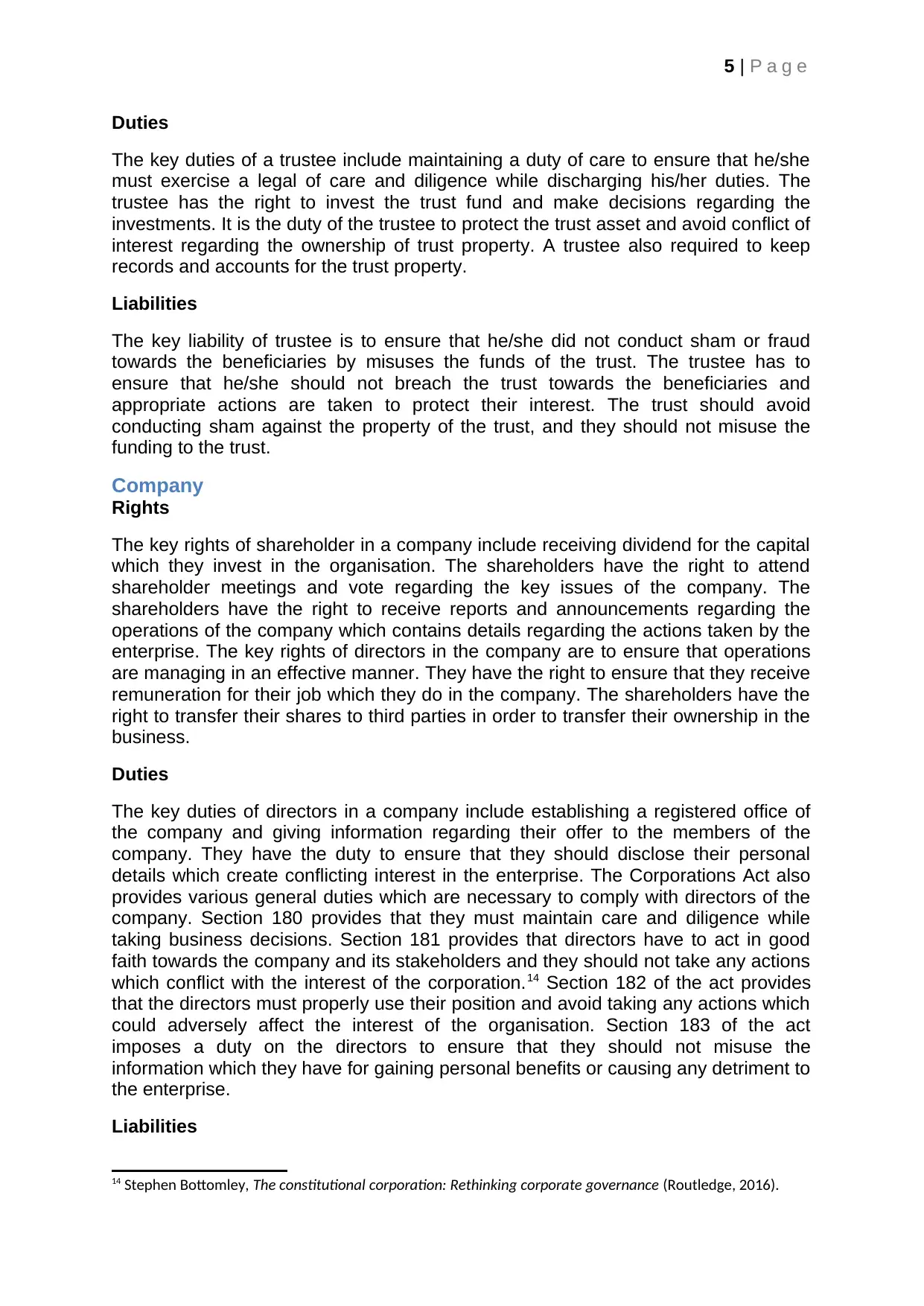
5 | P a g e
Duties
The key duties of a trustee include maintaining a duty of care to ensure that he/she
must exercise a legal of care and diligence while discharging his/her duties. The
trustee has the right to invest the trust fund and make decisions regarding the
investments. It is the duty of the trustee to protect the trust asset and avoid conflict of
interest regarding the ownership of trust property. A trustee also required to keep
records and accounts for the trust property.
Liabilities
The key liability of trustee is to ensure that he/she did not conduct sham or fraud
towards the beneficiaries by misuses the funds of the trust. The trustee has to
ensure that he/she should not breach the trust towards the beneficiaries and
appropriate actions are taken to protect their interest. The trust should avoid
conducting sham against the property of the trust, and they should not misuse the
funding to the trust.
Company
Rights
The key rights of shareholder in a company include receiving dividend for the capital
which they invest in the organisation. The shareholders have the right to attend
shareholder meetings and vote regarding the key issues of the company. The
shareholders have the right to receive reports and announcements regarding the
operations of the company which contains details regarding the actions taken by the
enterprise. The key rights of directors in the company are to ensure that operations
are managing in an effective manner. They have the right to ensure that they receive
remuneration for their job which they do in the company. The shareholders have the
right to transfer their shares to third parties in order to transfer their ownership in the
business.
Duties
The key duties of directors in a company include establishing a registered office of
the company and giving information regarding their offer to the members of the
company. They have the duty to ensure that they should disclose their personal
details which create conflicting interest in the enterprise. The Corporations Act also
provides various general duties which are necessary to comply with directors of the
company. Section 180 provides that they must maintain care and diligence while
taking business decisions. Section 181 provides that directors have to act in good
faith towards the company and its stakeholders and they should not take any actions
which conflict with the interest of the corporation.14 Section 182 of the act provides
that the directors must properly use their position and avoid taking any actions which
could adversely affect the interest of the organisation. Section 183 of the act
imposes a duty on the directors to ensure that they should not misuse the
information which they have for gaining personal benefits or causing any detriment to
the enterprise.
Liabilities
14 Stephen Bottomley, The constitutional corporation: Rethinking corporate governance (Routledge, 2016).
Duties
The key duties of a trustee include maintaining a duty of care to ensure that he/she
must exercise a legal of care and diligence while discharging his/her duties. The
trustee has the right to invest the trust fund and make decisions regarding the
investments. It is the duty of the trustee to protect the trust asset and avoid conflict of
interest regarding the ownership of trust property. A trustee also required to keep
records and accounts for the trust property.
Liabilities
The key liability of trustee is to ensure that he/she did not conduct sham or fraud
towards the beneficiaries by misuses the funds of the trust. The trustee has to
ensure that he/she should not breach the trust towards the beneficiaries and
appropriate actions are taken to protect their interest. The trust should avoid
conducting sham against the property of the trust, and they should not misuse the
funding to the trust.
Company
Rights
The key rights of shareholder in a company include receiving dividend for the capital
which they invest in the organisation. The shareholders have the right to attend
shareholder meetings and vote regarding the key issues of the company. The
shareholders have the right to receive reports and announcements regarding the
operations of the company which contains details regarding the actions taken by the
enterprise. The key rights of directors in the company are to ensure that operations
are managing in an effective manner. They have the right to ensure that they receive
remuneration for their job which they do in the company. The shareholders have the
right to transfer their shares to third parties in order to transfer their ownership in the
business.
Duties
The key duties of directors in a company include establishing a registered office of
the company and giving information regarding their offer to the members of the
company. They have the duty to ensure that they should disclose their personal
details which create conflicting interest in the enterprise. The Corporations Act also
provides various general duties which are necessary to comply with directors of the
company. Section 180 provides that they must maintain care and diligence while
taking business decisions. Section 181 provides that directors have to act in good
faith towards the company and its stakeholders and they should not take any actions
which conflict with the interest of the corporation.14 Section 182 of the act provides
that the directors must properly use their position and avoid taking any actions which
could adversely affect the interest of the organisation. Section 183 of the act
imposes a duty on the directors to ensure that they should not misuse the
information which they have for gaining personal benefits or causing any detriment to
the enterprise.
Liabilities
14 Stephen Bottomley, The constitutional corporation: Rethinking corporate governance (Routledge, 2016).
⊘ This is a preview!⊘
Do you want full access?
Subscribe today to unlock all pages.

Trusted by 1+ million students worldwide
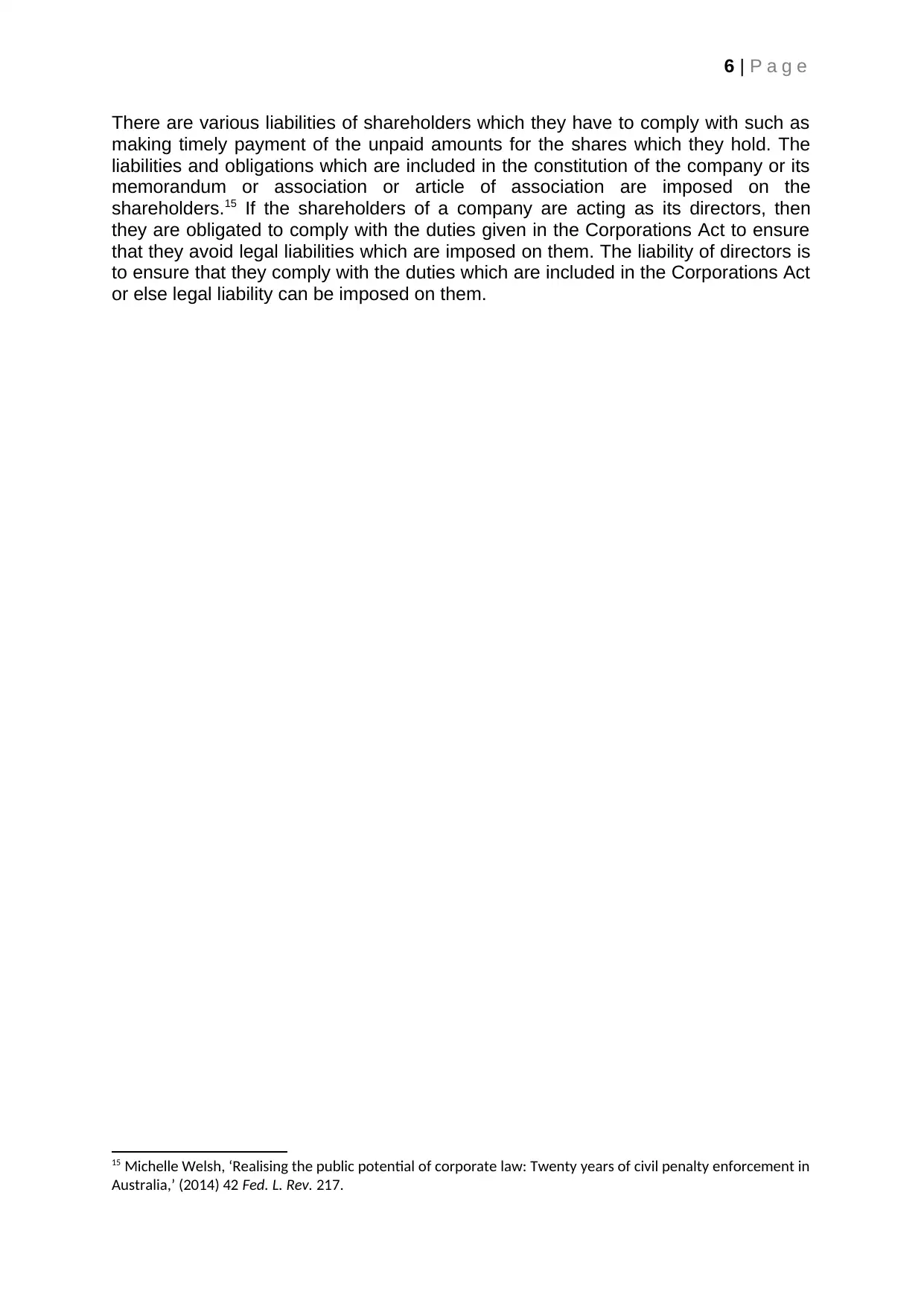
6 | P a g e
There are various liabilities of shareholders which they have to comply with such as
making timely payment of the unpaid amounts for the shares which they hold. The
liabilities and obligations which are included in the constitution of the company or its
memorandum or association or article of association are imposed on the
shareholders.15 If the shareholders of a company are acting as its directors, then
they are obligated to comply with the duties given in the Corporations Act to ensure
that they avoid legal liabilities which are imposed on them. The liability of directors is
to ensure that they comply with the duties which are included in the Corporations Act
or else legal liability can be imposed on them.
15 Michelle Welsh, ‘Realising the public potential of corporate law: Twenty years of civil penalty enforcement in
Australia,’ (2014) 42 Fed. L. Rev. 217.
There are various liabilities of shareholders which they have to comply with such as
making timely payment of the unpaid amounts for the shares which they hold. The
liabilities and obligations which are included in the constitution of the company or its
memorandum or association or article of association are imposed on the
shareholders.15 If the shareholders of a company are acting as its directors, then
they are obligated to comply with the duties given in the Corporations Act to ensure
that they avoid legal liabilities which are imposed on them. The liability of directors is
to ensure that they comply with the duties which are included in the Corporations Act
or else legal liability can be imposed on them.
15 Michelle Welsh, ‘Realising the public potential of corporate law: Twenty years of civil penalty enforcement in
Australia,’ (2014) 42 Fed. L. Rev. 217.
Paraphrase This Document
Need a fresh take? Get an instant paraphrase of this document with our AI Paraphraser
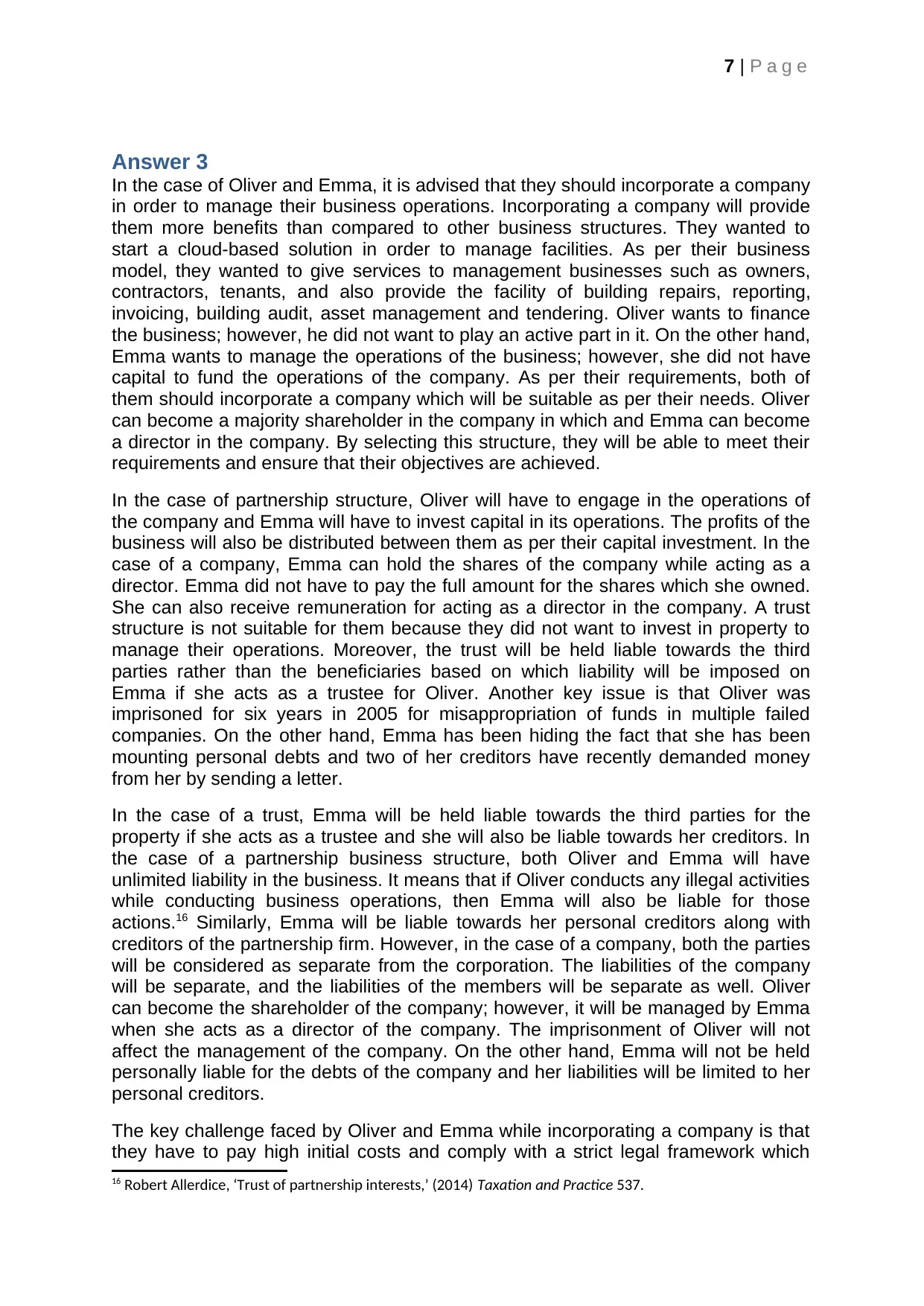
7 | P a g e
Answer 3
In the case of Oliver and Emma, it is advised that they should incorporate a company
in order to manage their business operations. Incorporating a company will provide
them more benefits than compared to other business structures. They wanted to
start a cloud-based solution in order to manage facilities. As per their business
model, they wanted to give services to management businesses such as owners,
contractors, tenants, and also provide the facility of building repairs, reporting,
invoicing, building audit, asset management and tendering. Oliver wants to finance
the business; however, he did not want to play an active part in it. On the other hand,
Emma wants to manage the operations of the business; however, she did not have
capital to fund the operations of the company. As per their requirements, both of
them should incorporate a company which will be suitable as per their needs. Oliver
can become a majority shareholder in the company in which and Emma can become
a director in the company. By selecting this structure, they will be able to meet their
requirements and ensure that their objectives are achieved.
In the case of partnership structure, Oliver will have to engage in the operations of
the company and Emma will have to invest capital in its operations. The profits of the
business will also be distributed between them as per their capital investment. In the
case of a company, Emma can hold the shares of the company while acting as a
director. Emma did not have to pay the full amount for the shares which she owned.
She can also receive remuneration for acting as a director in the company. A trust
structure is not suitable for them because they did not want to invest in property to
manage their operations. Moreover, the trust will be held liable towards the third
parties rather than the beneficiaries based on which liability will be imposed on
Emma if she acts as a trustee for Oliver. Another key issue is that Oliver was
imprisoned for six years in 2005 for misappropriation of funds in multiple failed
companies. On the other hand, Emma has been hiding the fact that she has been
mounting personal debts and two of her creditors have recently demanded money
from her by sending a letter.
In the case of a trust, Emma will be held liable towards the third parties for the
property if she acts as a trustee and she will also be liable towards her creditors. In
the case of a partnership business structure, both Oliver and Emma will have
unlimited liability in the business. It means that if Oliver conducts any illegal activities
while conducting business operations, then Emma will also be liable for those
actions.16 Similarly, Emma will be liable towards her personal creditors along with
creditors of the partnership firm. However, in the case of a company, both the parties
will be considered as separate from the corporation. The liabilities of the company
will be separate, and the liabilities of the members will be separate as well. Oliver
can become the shareholder of the company; however, it will be managed by Emma
when she acts as a director of the company. The imprisonment of Oliver will not
affect the management of the company. On the other hand, Emma will not be held
personally liable for the debts of the company and her liabilities will be limited to her
personal creditors.
The key challenge faced by Oliver and Emma while incorporating a company is that
they have to pay high initial costs and comply with a strict legal framework which
16 Robert Allerdice, ‘Trust of partnership interests,’ (2014) Taxation and Practice 537.
Answer 3
In the case of Oliver and Emma, it is advised that they should incorporate a company
in order to manage their business operations. Incorporating a company will provide
them more benefits than compared to other business structures. They wanted to
start a cloud-based solution in order to manage facilities. As per their business
model, they wanted to give services to management businesses such as owners,
contractors, tenants, and also provide the facility of building repairs, reporting,
invoicing, building audit, asset management and tendering. Oliver wants to finance
the business; however, he did not want to play an active part in it. On the other hand,
Emma wants to manage the operations of the business; however, she did not have
capital to fund the operations of the company. As per their requirements, both of
them should incorporate a company which will be suitable as per their needs. Oliver
can become a majority shareholder in the company in which and Emma can become
a director in the company. By selecting this structure, they will be able to meet their
requirements and ensure that their objectives are achieved.
In the case of partnership structure, Oliver will have to engage in the operations of
the company and Emma will have to invest capital in its operations. The profits of the
business will also be distributed between them as per their capital investment. In the
case of a company, Emma can hold the shares of the company while acting as a
director. Emma did not have to pay the full amount for the shares which she owned.
She can also receive remuneration for acting as a director in the company. A trust
structure is not suitable for them because they did not want to invest in property to
manage their operations. Moreover, the trust will be held liable towards the third
parties rather than the beneficiaries based on which liability will be imposed on
Emma if she acts as a trustee for Oliver. Another key issue is that Oliver was
imprisoned for six years in 2005 for misappropriation of funds in multiple failed
companies. On the other hand, Emma has been hiding the fact that she has been
mounting personal debts and two of her creditors have recently demanded money
from her by sending a letter.
In the case of a trust, Emma will be held liable towards the third parties for the
property if she acts as a trustee and she will also be liable towards her creditors. In
the case of a partnership business structure, both Oliver and Emma will have
unlimited liability in the business. It means that if Oliver conducts any illegal activities
while conducting business operations, then Emma will also be liable for those
actions.16 Similarly, Emma will be liable towards her personal creditors along with
creditors of the partnership firm. However, in the case of a company, both the parties
will be considered as separate from the corporation. The liabilities of the company
will be separate, and the liabilities of the members will be separate as well. Oliver
can become the shareholder of the company; however, it will be managed by Emma
when she acts as a director of the company. The imprisonment of Oliver will not
affect the management of the company. On the other hand, Emma will not be held
personally liable for the debts of the company and her liabilities will be limited to her
personal creditors.
The key challenge faced by Oliver and Emma while incorporating a company is that
they have to pay high initial costs and comply with a strict legal framework which
16 Robert Allerdice, ‘Trust of partnership interests,’ (2014) Taxation and Practice 537.
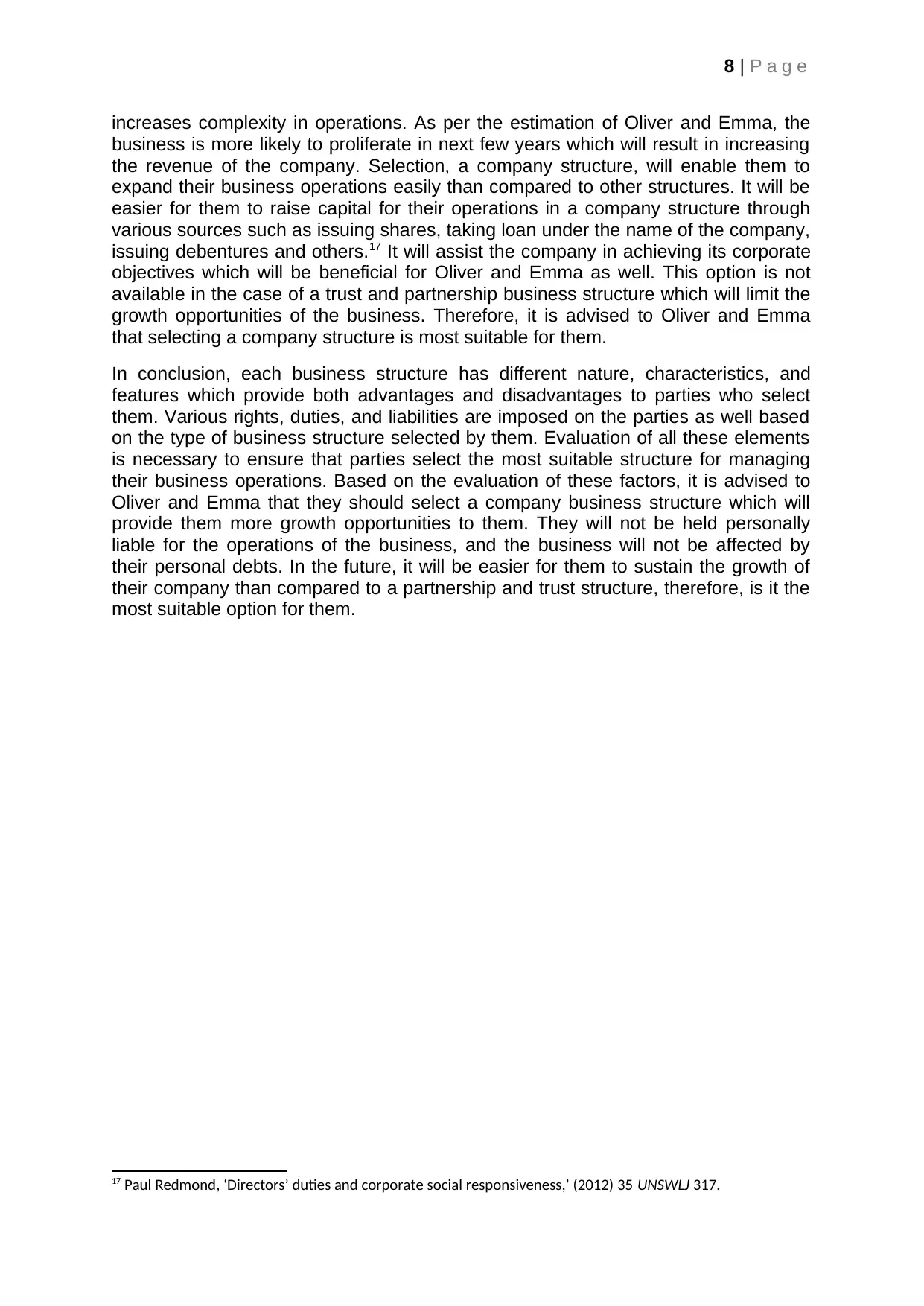
8 | P a g e
increases complexity in operations. As per the estimation of Oliver and Emma, the
business is more likely to proliferate in next few years which will result in increasing
the revenue of the company. Selection, a company structure, will enable them to
expand their business operations easily than compared to other structures. It will be
easier for them to raise capital for their operations in a company structure through
various sources such as issuing shares, taking loan under the name of the company,
issuing debentures and others.17 It will assist the company in achieving its corporate
objectives which will be beneficial for Oliver and Emma as well. This option is not
available in the case of a trust and partnership business structure which will limit the
growth opportunities of the business. Therefore, it is advised to Oliver and Emma
that selecting a company structure is most suitable for them.
In conclusion, each business structure has different nature, characteristics, and
features which provide both advantages and disadvantages to parties who select
them. Various rights, duties, and liabilities are imposed on the parties as well based
on the type of business structure selected by them. Evaluation of all these elements
is necessary to ensure that parties select the most suitable structure for managing
their business operations. Based on the evaluation of these factors, it is advised to
Oliver and Emma that they should select a company business structure which will
provide them more growth opportunities to them. They will not be held personally
liable for the operations of the business, and the business will not be affected by
their personal debts. In the future, it will be easier for them to sustain the growth of
their company than compared to a partnership and trust structure, therefore, is it the
most suitable option for them.
17 Paul Redmond, ‘Directors’ duties and corporate social responsiveness,’ (2012) 35 UNSWLJ 317.
increases complexity in operations. As per the estimation of Oliver and Emma, the
business is more likely to proliferate in next few years which will result in increasing
the revenue of the company. Selection, a company structure, will enable them to
expand their business operations easily than compared to other structures. It will be
easier for them to raise capital for their operations in a company structure through
various sources such as issuing shares, taking loan under the name of the company,
issuing debentures and others.17 It will assist the company in achieving its corporate
objectives which will be beneficial for Oliver and Emma as well. This option is not
available in the case of a trust and partnership business structure which will limit the
growth opportunities of the business. Therefore, it is advised to Oliver and Emma
that selecting a company structure is most suitable for them.
In conclusion, each business structure has different nature, characteristics, and
features which provide both advantages and disadvantages to parties who select
them. Various rights, duties, and liabilities are imposed on the parties as well based
on the type of business structure selected by them. Evaluation of all these elements
is necessary to ensure that parties select the most suitable structure for managing
their business operations. Based on the evaluation of these factors, it is advised to
Oliver and Emma that they should select a company business structure which will
provide them more growth opportunities to them. They will not be held personally
liable for the operations of the business, and the business will not be affected by
their personal debts. In the future, it will be easier for them to sustain the growth of
their company than compared to a partnership and trust structure, therefore, is it the
most suitable option for them.
17 Paul Redmond, ‘Directors’ duties and corporate social responsiveness,’ (2012) 35 UNSWLJ 317.
⊘ This is a preview!⊘
Do you want full access?
Subscribe today to unlock all pages.

Trusted by 1+ million students worldwide
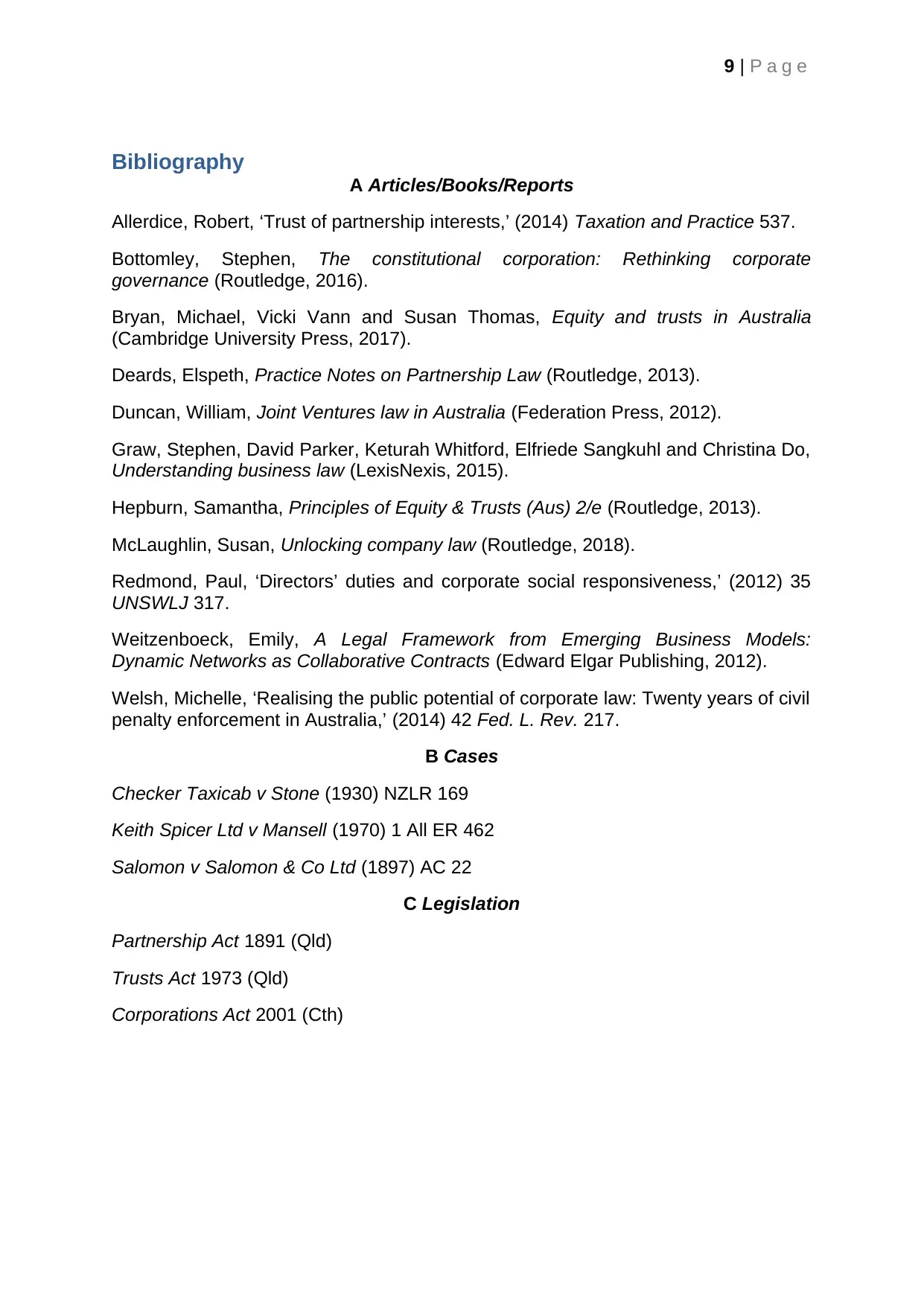
9 | P a g e
Bibliography
A Articles/Books/Reports
Allerdice, Robert, ‘Trust of partnership interests,’ (2014) Taxation and Practice 537.
Bottomley, Stephen, The constitutional corporation: Rethinking corporate
governance (Routledge, 2016).
Bryan, Michael, Vicki Vann and Susan Thomas, Equity and trusts in Australia
(Cambridge University Press, 2017).
Deards, Elspeth, Practice Notes on Partnership Law (Routledge, 2013).
Duncan, William, Joint Ventures law in Australia (Federation Press, 2012).
Graw, Stephen, David Parker, Keturah Whitford, Elfriede Sangkuhl and Christina Do,
Understanding business law (LexisNexis, 2015).
Hepburn, Samantha, Principles of Equity & Trusts (Aus) 2/e (Routledge, 2013).
McLaughlin, Susan, Unlocking company law (Routledge, 2018).
Redmond, Paul, ‘Directors’ duties and corporate social responsiveness,’ (2012) 35
UNSWLJ 317.
Weitzenboeck, Emily, A Legal Framework from Emerging Business Models:
Dynamic Networks as Collaborative Contracts (Edward Elgar Publishing, 2012).
Welsh, Michelle, ‘Realising the public potential of corporate law: Twenty years of civil
penalty enforcement in Australia,’ (2014) 42 Fed. L. Rev. 217.
B Cases
Checker Taxicab v Stone (1930) NZLR 169
Keith Spicer Ltd v Mansell (1970) 1 All ER 462
Salomon v Salomon & Co Ltd (1897) AC 22
C Legislation
Partnership Act 1891 (Qld)
Trusts Act 1973 (Qld)
Corporations Act 2001 (Cth)
Bibliography
A Articles/Books/Reports
Allerdice, Robert, ‘Trust of partnership interests,’ (2014) Taxation and Practice 537.
Bottomley, Stephen, The constitutional corporation: Rethinking corporate
governance (Routledge, 2016).
Bryan, Michael, Vicki Vann and Susan Thomas, Equity and trusts in Australia
(Cambridge University Press, 2017).
Deards, Elspeth, Practice Notes on Partnership Law (Routledge, 2013).
Duncan, William, Joint Ventures law in Australia (Federation Press, 2012).
Graw, Stephen, David Parker, Keturah Whitford, Elfriede Sangkuhl and Christina Do,
Understanding business law (LexisNexis, 2015).
Hepburn, Samantha, Principles of Equity & Trusts (Aus) 2/e (Routledge, 2013).
McLaughlin, Susan, Unlocking company law (Routledge, 2018).
Redmond, Paul, ‘Directors’ duties and corporate social responsiveness,’ (2012) 35
UNSWLJ 317.
Weitzenboeck, Emily, A Legal Framework from Emerging Business Models:
Dynamic Networks as Collaborative Contracts (Edward Elgar Publishing, 2012).
Welsh, Michelle, ‘Realising the public potential of corporate law: Twenty years of civil
penalty enforcement in Australia,’ (2014) 42 Fed. L. Rev. 217.
B Cases
Checker Taxicab v Stone (1930) NZLR 169
Keith Spicer Ltd v Mansell (1970) 1 All ER 462
Salomon v Salomon & Co Ltd (1897) AC 22
C Legislation
Partnership Act 1891 (Qld)
Trusts Act 1973 (Qld)
Corporations Act 2001 (Cth)
1 out of 10
Related Documents
Your All-in-One AI-Powered Toolkit for Academic Success.
+13062052269
info@desklib.com
Available 24*7 on WhatsApp / Email
![[object Object]](/_next/static/media/star-bottom.7253800d.svg)
Unlock your academic potential
Copyright © 2020–2025 A2Z Services. All Rights Reserved. Developed and managed by ZUCOL.





